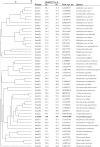Novel macrolide-lincosamide-streptogramin B resistance gene erm(56) in Trueperella pyogenes
- PMID: 37417762
- PMCID: PMC10470526
- DOI: 10.1128/msphere.00239-23
Novel macrolide-lincosamide-streptogramin B resistance gene erm(56) in Trueperella pyogenes
Abstract
Whole-genome sequence analysis of a macrolide, lincosamide, streptogramin B (MLSB)-resistant Trueperella pyogenes from a dog revealed a new 23S ribosomal RNA methylase gene erm(56). Expression of the cloned erm(56) confers resistance to MLSB in T. pyogenes and Escherichia coli. The erm(56) gene was flanked by two IS6100 integrated on the chromosome next to a sul1-containing class 1 integron. GenBank query revealed additional erm(56)-containing elements in another T. pyogenes and in Rothia nasimurium from livestock. IMPORTANCE A novel 23S ribosomal RNA methylase gene erm(56) flanked by insertion sequence IS6100 was identified in a Trueperella pyogenes isolated from the abscess of a dog and was also present in another T. pyogenes and in Rothia nasimurium from livestock. It was shown to confer resistance to macrolide, lincosamide, streptogramin B antibiotics in T. pyogenes and E. coli, indicating functionality in both Gram-positive and Gram-negative bacteria. The detection of erm(56) on different elements in unrelated bacteria from different animal sources and geographical origins suggests that it has been independently acquired and likely selected by the use of antibiotics in animals.
Keywords: DNA sequencing; gene expression; macrolides-lincosamides-streptogramin B; mechanisms of resistance.
Conflict of interest statement
The authors declare no conflict of interest.
Figures


References
Publication types
MeSH terms
Substances
Supplementary concepts
LinkOut - more resources
Full Text Sources
Medical

